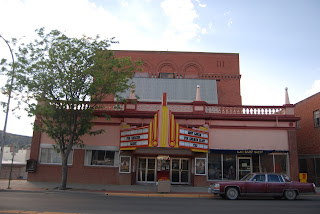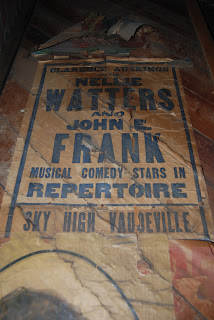The Fox Theater of Trinidad, Colorado is a gem, a monument to a time and a place in American history that may never be repeated. Ed West was a cattle rancher and entrepreneur in the post-Gold Rush days of western Colorado: he owned or helped finance many of the storefronts along Main Street. But beyond what may be coined today as "vulture" capitalism, Ed West took and used his profits, to make something out of nothing: the West Theater, a $125,000 performing arts center ($3.1 million, in today's terms), was conceived of following the closure of the second-floor Jaffa Opera House, a few blocks away. West's vision was not merely to provide Trinidad-- ninety minutes south of Pueblo-- a new stage on which locals may work up their own productions. The West Theater sought to be a grand and comprehensive affair, able to accommodate the largest traveling shows in the world, from the spectacles of Vaudeville to intimate dramatization.
 The
Fox Theater was not constructed as a movie house. I.H. and W.M. Rapp,
two brothers from a famous family of American architects, designed the
place for acoustics, not projection (another pair of brothers, from the
same family-- George and C.W.-- would design some of the great Art Deco
movie palaces decades hence). Construction began in mid-February of
1907, and would not be completed until March of 1908: because, unlike
the utility and efficacy of today's 'nickelodeon' multiplexes, the
experience of the theater patron was to be transformative, majestic,
grand in every sense of the word. Thus, Ed West's theater was comprised
not only of a 1,150-seat auditorium (with two balconies, two luxury
boxes, and a full-sized orchestra pit), but also two adjoining
storefronts built into the complex, as well as a full ballroom in the
basement, beneath the carefully-inclined floors of the lobby and
theater. Half of the ballroom is literally underground, and the back
wall of the building-- the tallest, to accommodate the complex rigging
and catwalks-- towers, nearly 170 feet from ground level.
The
Fox Theater was not constructed as a movie house. I.H. and W.M. Rapp,
two brothers from a famous family of American architects, designed the
place for acoustics, not projection (another pair of brothers, from the
same family-- George and C.W.-- would design some of the great Art Deco
movie palaces decades hence). Construction began in mid-February of
1907, and would not be completed until March of 1908: because, unlike
the utility and efficacy of today's 'nickelodeon' multiplexes, the
experience of the theater patron was to be transformative, majestic,
grand in every sense of the word. Thus, Ed West's theater was comprised
not only of a 1,150-seat auditorium (with two balconies, two luxury
boxes, and a full-sized orchestra pit), but also two adjoining
storefronts built into the complex, as well as a full ballroom in the
basement, beneath the carefully-inclined floors of the lobby and
theater. Half of the ballroom is literally underground, and the back
wall of the building-- the tallest, to accommodate the complex rigging
and catwalks-- towers, nearly 170 feet from ground level.Ed West lived a bit more than a decade after the opening of his palace: in that time, the place was host to uncounted stars of the early twentieth century. A collection of deteriorating posters still attached to a brick wall and wooden door in the boiler room told tales of opulence and fantasy, promising "you'll laugh til you..." After West's death in 1920, the theater was sold, and sold again: by October of 1929, the Fox West Theater Company had purchased it, 'talkies' had been running for six months. Fox added a neon marquee, and made other aesthetic changes, as patrons began to expect the projection of moving images, over seeing live humans move about the mammoth stage. Fox sold the theater in 1959, to the Sawaya family, who still keep the place in operation; Michael Hadad, the owners' nephew, operates the projector, runs the concession stand, and hands out tickets.
At the time of this writing, the Fox Theater of Trinidad, Colorado is unrestored: a jumble of renovations has left the building in stable, but haphazard condition. The lobby sports at least three distinct patterns of carpet, including remnants of a striking art deco design, matched oddly against the flowing and prominent Fleur-de-lis pattern. In 1908, the Rapp brothers were likely seeking a Renassaince style, in the gold ornamentation of columns, and ornate staircase handrails that lead to the first balcony. But the style of other eras is clearly present: the lilting light fixtures that appear to be from the 1930s; the boxy, streamlined additional wall lights could be from the 1940s; the photograph of a paper cup filled with ice and soft drinks hanging behind the snack bar may have been from the 1970s. The second balcony (the 'gallery,' containing wooden benches) has been closed for decades; the first balcony appears to have seldom seen much use, its matching stairways blocked (on one landing rests the theater's original telephone booth). The box office is itself a museum of theater technology: a microfridge-sized ticket printing machine, a mechanical adding machine, and a house telephone, wired to a system long disused. The front lobby has a tile floor; wooden frames for movie posters line the walls, and are themselves lined with small frames of square mirrors, another aesthetic. The main floor of the auditorium is filled with perhaps the finest movie theater seat I've had the opportunity to know: manufactured in the 1940s, the seat itself is padded, with springs, and one may push back on the seat to recline more comfortably. Aside from the row of hot water radiators across the floor at the edge of the stage-- installed to simplify heating the massive structure-- the auditorium is intact and still invites awe. I saw no peeling paint, no mold or rot. As I photographed, I found little light available-- no seams of brightness pouring in from the roof, nothing. The arid conditions and lack of all windows (Michael referred to the theater a few times as a "lightsink") have preserved all of its systems.
I was invited on stage, for photographs; I ended up singing. With my back to a massive silver screen, I immediately forgot the place was ever a movie house: I could hear a pin drop, literally, and, standing at center, had a line of sight to every seat in the house, including the thin shadows of the third balcony. Architectural details combined to create a literal megaphone for those performing: the proscenium arch and circular ceiling (with mysterious and intricate circular light fixture!) made clear the building's ability to amplify, anyone, anyhow. There has never been a theatrical amplification system installed at the Fox Theater, and, should this venue ever return to offering live performance, it wouldn't need one-- not for a rock band, jazz quartet, or poetry reading. While I have experienced incredible acoustic manipulation in churches and cathedrals in the United States and elsewhere, the Fox stands far apart from these, as there was, in my brief and breathy rendition of "Ol' Man River," no echo or reverberation apparent. From center stage to a dark house, I heard my own voice as I never had before.
Sound reproduction for motion pictures evolved during the last century, and the Fox took these technological changes in stride. Departing from 16mm optical sound sometime in the 1950s or 60s, the Fox had an extensive multi-channel sound system installed, one that required speakers on the sides and back wall, as well as behind the screen itself. Variations on the theater's original amplification system, in combination with Fox the studio's innovations in multi-channel and magnetic sound recording, served moviegoers, until 2005, when complete conversion to 35mm sound was made. A multi-stage amplifier replaced the theater's original tube amp at that time-- though the speakers installed on the side and back walls are still used. In conversation, Michael Hadad lamented the coming "conversion," of movie theaters from 35mm platter projectors, to a proprietary server-and-hard-drive system studios claim will be in place, "at theaters nationwide," by the spring of 2013. Not being the only game in town, the Fox Theater in Trinidad hopes to maintain and expand its base of patrons, as new technology is imposed, delivered, installed: Michael wouldn't speculate as much about the Fox Theater's future, as much as he would on the reliability of the new equipment that would be coming ("a bulb that will burn for half as long and cost twice as much"). Meanwhile, the original electrical panel, that did operate stage lights and house lights, loomed backstage at us, as my tour concluded: all copper, all hand-wired and hand-labeled, and all still in complete operation. From the lobby to the light panel, and all of the nooks and rooms I didn't see, have gone unseens for decades, the Fox Theater is a gem. Even to honor our royalty, even to recognize and commemorate our most special events and anniversaries, we don't, and may never again, imagine ourselves immersed in such magnificence.
For more information, call the Fox Theater of Trinidad, Colorado: (719) 846-2851
Inside the Box Office
Chair in Box Office
Exterior Lobby Tile Floor
Exterior Lobby Door Fixture
Between Interior and Exterior Lobbies
Interior Lobby
Balcony Stairs
Phone Booth
Interior Lobby Staircase Detail
Art Deco Carpet
Interior Lobby Detail
Back Wall of Auditorium
Radiator Pipes, Installed at Foot of Stage, Above Orchestra Pit
Balcony and Gallery (Projection Booth in Balcony)
From Center Stage
Site of Former Pipe Organ
Stage Edge
Speaker on Back Wall
Reclining Seats
Note Staircase'd Floor for Seats
Fixture, Inside Auditorium
Fixture, Inside Auditorium
Backstage: Lighting Control Panel
Backstage
Names Carved on Stone, Stage Left Door
Posters in Boiler Room, on Stage Left Door
Light Control Panel Detail




















































































Hi your article is really very impressive and colorful as well im wishing the all the success like Operation Theater Lights
ReplyDeleteVisit : http://www.psblinternational.com/operation-theatre-lights.htm
Hi your blog is very informative and suggestible thanks for your post as well i wishing the all the success like Operation Theater beds
ReplyDeleteVisit : http://www.psblinternational.com/operation-theatre-lights.htm